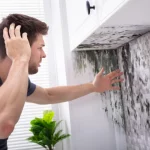
Image Credit: Maid Brigade
It often surprises a homeowner to learn that even if a home could pass a white-glove test, it might harbor a mold infestation. Although mold is present nearly everywhere, indoors and outdoors, when it invades a home, health problems can follow.
What Exactly Is Mold?
Molds are a type of fungi. They serve as natural recyclers by helping break down dead material. The most common types found indoors are Cladosporium, Penicillium, Alternaria, and Aspergillus.
Every type of mold thrives in warm, damp, and humid environments and reproduces by generating spores. These tiny cells float in the air and spread very easily.
When they land in just the right conditions, they form new colonies of mold. The fungus is so hardy that spores can survive in dry conditions unlikely to foster growth.
Mold can quickly reproduce. It can spread throughout your home in just 48 to 72 hours. But the most important question is how to control mold in your home immediately.
Even in a seemingly pristine residence, the fungus could be lurking. To reproduce, it needs only moisture, oxygen, a source of food, and a surface on which to grow. Here are the places where it thrives:
- Walls
- Floors
- Ceilings
- Carpets
- Fabrics exposed to moisture
- Showers
- Surfaces of building materials
- Behind wallpaper
- Refrigerator Gaskets
- Heating and air conditioning ductwork
Mold particularly loves ductwork. It gets nutrients from dust on the surface of system components. Moisture is readily available from condensation generated by an air conditioning coil, a faulty humidifier connected to the heating/cooling system, or even high humidity.
Often a homeowner has no idea mold is present until signs of illness appear or water damage occurs after a storm or a plumbing leak.
It’s even possible that a small mold problem could have been missed by the inspection when they bought the home. In many cases when the fungus is outside ductwork or walls, it’s possible to see signs of it or detect a strong musty smell.
Visible mold has a variety of textures and might appear white, black, green, yellow, gray, or brown. Finding it inside a wall is a bit tougher and normally requires professional testing.
Dangers to Your Health
Some people are more sensitive to mold than others are. Breathing the spores triggers an overreaction by the immune system. This can cause coughing, sneezing, and itchy eyes.
Other common symptoms include a running or a stuffy nose, a postnasal drip, a sore throat, and watery eyes.
Sometimes mold exposure causes the skin to become dry and scaly. In individuals with asthma, inhaling mold can result in restricted breathing, coughing, wheezing, chest tightness, or a severe asthma attack.
Signs of an allergic reaction to mold can vary from mild to severe. Some individuals experience them all year, while others have flares only during certain periods.
Being in damp weather or in spaces indoors or outdoors with high mold concentrations acutely bothers some people.
Some individuals have particular risk factors for mold sensitivity. These include:
- A family history of allergies
- Being immunosuppressed
- Living in high humidity
- Living in a home exposed to excessive moisture
- Residing in a residence with poor ventilation
- Being an infant, a child, or a senior
How Professionals Can Help
Even normal living generates quite a few pollutants and contaminants in a home. An HVAC system pulls mold, dust, pet dander, and chemicals into it and recirculates them five to seven times every day.
Problems with mold or other issues with the air quality in a residence require the expertise of professionals. Once the mold has been diagnosed, after mold testing, the first step to eliminating it is to remove any sources of water or other moisture. Otherwise, you might see more mold.
If mold is in your heating and cooling system, air duct cleaning by professionals is necessary. Professional mold remediation contractors are also experts at testing and eliminating mold in other parts of a residence, such as walls and ceilings.
Why take the risk of being exposed to mold in your home? Contact an expert to inspect your residence and make sure your indoor air quality is exactly what it should be.
About The Author:
Gary Ashton is the CEO and owner of The Ashton Real Estate Group of RE/MAX Advantage. His real estate team is #1 in Tennessee, Nashville and now #4 in the world.




